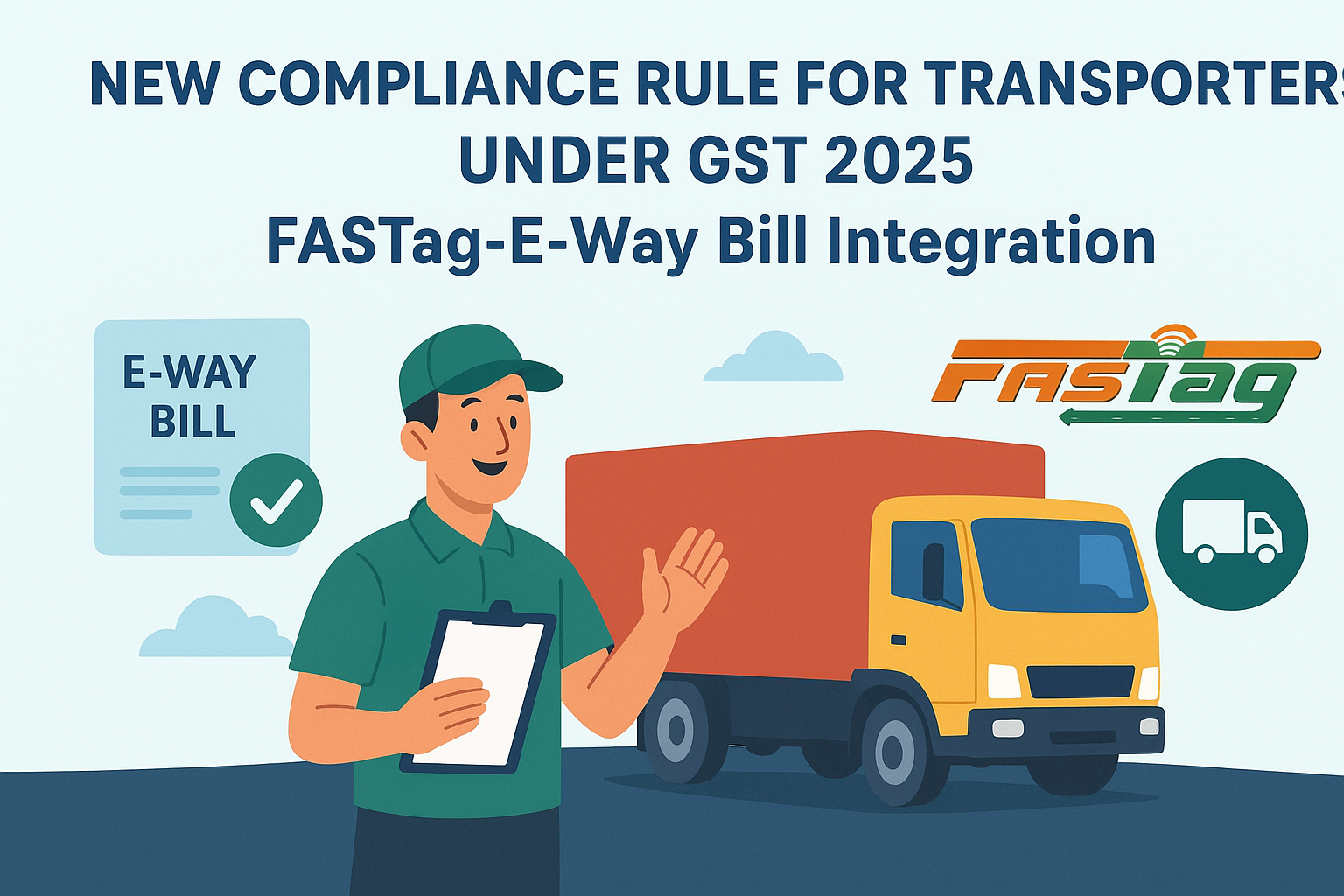The Goods and Services Tax (GST) regime in India has continuously evolved since its introduction in 2017. The government has been working to plug revenue leakages, reduce tax evasion, and bring more transparency into the system. One of the latest changes introduced in 2025 is a new compliance rule for transporters, which links FASTag data with GST e-way bills. This rule is expected to come into effect from November 2025 and will have a major impact on businesses engaged in goods transport, logistics providers, and consignors.
Table of Contents
What is the New Compliance Rule for Transporters?
From November 2025, the government has mandated that every vehicle transporting goods under an e-way bill will be automatically tracked through its FASTag system. FASTag, the electronic toll collection system, records vehicle entries at toll plazas in real time. By integrating this data with the GST e-way bill system, the government aims to verify whether goods are actually moving along the declared route.
In simpler words, the GST system will now cross-check vehicle movement against the details entered in the e-way bill. If discrepancies are found, such as a mismatch in vehicle numbers or suspicious routing, the system will generate alerts for GST authorities.
Why is This Rule Introduced?
The key reasons for introducing this compliance measure are:
- Curbing fake invoicing: Many businesses were creating fake e-way bills without actual movement of goods to claim Input Tax Credit (ITC).
- Preventing tax evasion: Some transporters were misreporting vehicle numbers or using alternate routes to avoid scrutiny.
- Increasing accountability: Linking real-time movement with GST records ensures that consignors and transporters cannot manipulate data.
- Enhancing transparency: Automated monitoring will reduce manual checks and corruption at checkpoints.
How Will the Rule Work?
- E-way Bill Generation – A business or transporter generates an e-way bill before moving goods worth more than ₹50,000. The bill contains details like vehicle number, consignor, consignee, and route.
- FASTag Tracking – When the vehicle crosses a toll plaza, the FASTag data (vehicle number, time, and location) is automatically recorded.
- System Integration – The GST portal will fetch FASTag data and compare it with the e-way bill details.
- Mismatch Alerts – If the declared route or vehicle does not match the toll data, the system will flag it for scrutiny.
- Action by Authorities – GST officers may detain goods, impose penalties, or suspend the transporter’s facility to generate e-way bills in case of repeated violations.
Compliance Responsibilities for Transporters
To avoid penalties and delays, transporters must ensure:
- Accurate vehicle details – Always enter the correct vehicle number in the e-way bill.
- Timely updates – If a vehicle is changed during transit, update the e-way bill immediately.
- Declared route adherence – Ensure vehicles follow the route mentioned in the bill.
- Coordination with consignors – Businesses and transporters should work together to avoid errors.
Penalties for Non-Compliance under GST 2025
Non-compliance with the new rule can attract strict penalties, including:
- Detention of goods in transit.
- Penalty equal to the tax amount evaded, which can significantly increase costs Section 122 of the CGST Act, 2017.
- Suspension of e-way bill generation facility for repeat offenders, making it impossible to move goods legally.
- Additional fines under the CGST Act for deliberate misreporting.
Impact on Businesses and Transporters
For genuine businesses and transporters, this rule is a step towards simplified compliance and fair competition. Automated monitoring will reduce the need for physical inspections at checkpoints, leading to faster movement of goods. However, it also means that businesses must be more cautious with data entry and coordination.
Small businesses and local transporters may need some time to adapt, but the long-term benefits include reduced corruption, less paperwork, and faster refunds due to improved data accuracy.
Conclusion
The new GST compliance rule linking FASTag with e-way bills is a significant step in India’s fight against tax evasion. By leveraging technology, the government is ensuring that goods movement is transparent, traceable, and tamper-proof. While it may create initial challenges for transporters, the rule is expected to streamline logistics, improve revenue collection, and bring greater discipline to the GST framework.
For transporters and businesses, the key takeaway is simple: ensure accuracy, update details promptly, and comply with the rules to avoid penalties. Those who adapt early will benefit from smoother operations in the long run.
Contact Taxgiveindia.com for professional services.
